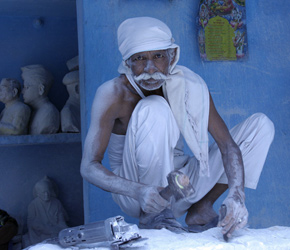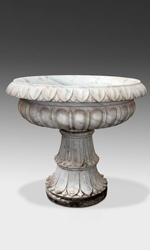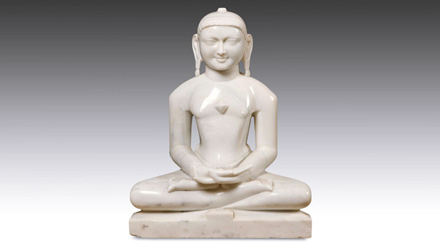Royal Stone – Makrana Marble Carving in India
PRIMITIVE - Friday, January 15, 2016By Misaki Imagawa
 |
|
The first half of the 20th century was marked by war and violence worldwide. In India, unrest flared against British colonial rule, manifesting itself in countless riots and mutinies across the subcontinent. During those tumultuous times there lived a man named Harij in Jaipur, Rajasthan. He was a humble marble carver who rose with the sun and dutifully went to his thatched roof workshop. There, he chiseled beautiful sculptures under the natural light as if he could heal the wounds of the world through art. When dusk fell, he brushed the stone dust from his clothes and walked into the old part of Jaipur, known as the Pink city. Upon his arrival those in need would crowd around knowing he would give what little alms he had; especially the children who had nowhere to go. Many were orphans who had lost their parents to massacres associated with demonstrations or conscription in the British army. Harij would often bring small carved figures with him and ask if anyone wanted to learn the art of carving marble. He took whoever was interested under his wing and would train them formally in the art known as Shilpa Shastra.
| on Lotus Base Rajasthan, India Contemporary Makrana marble 10.25 W x 11 D x 24 H inches ______________ Item #A0901-087" rel="lightbox"> |
|
An ancient term that translates as the 'science of arts and crafts,' Shilpa Shastra covers a wide range of decorative and sculptural disciplines such as painting, stone carving, carpentry, jewel making and pottery. The old Hindu texts of Shilpa Shastra address various design rules and principles such as proportion, composition and meaning, especially when it comes to the creation of deities and architecture. In essence, artists were given a roadmap to follow when creating images of gods and and buildings. In ancient India, the arts were open to all members of society regardless of class, caste or gender. Just as Harij had once apprenticed under a master carver, he now mentored street children, educating them in carving techniques and trade secrets as well as religion, history, culture, literacy and mathematics. He hoped they would help keep the heritage of Shilpa Shastra and marble carving alive, continuing the thousands year old tradition.
| Jaipur, Rajasthan, India Contemporary First quality makrana marble ______________ Item #A0901-090" rel="lightbox"> |
|
The history of stone carving in India reaches as far back as the Indus Valley Civilization (3300-1300 BCE). Guilds of masons have existed since the 7th century BCE; and of all the materials they dealt with it was marble that was regarded as the most important. Considered the 'royal stone,' it was used to build temples, tombs, palaces and other enduring monuments. Among the many inspiring architectural sites that can still be seen in India today are Jain Dilwara Temples built between the 11th and 14th century, Hoshang Shah's mausoleum built in the early 15th century, and the most famous of them all, the Taj Mahal, constructed purely from Makrana marble, in the 17th century.
| India Contemporary First quality makrana marble 21 W x 20 D x 41.5 H inches ______________ Item #A0901-091" rel="lightbox"> |
|
Makrana, located in Rajasthan, is considered one of the oldest and finest marble quarries in India. Marble is called metamorphic rock. Formed from limestone under conditions of high temperature and extreme pressure, it is the concentration of calcium carbonate in the limestone and presence of mineral impurities that determine the quality and whiteness of marble. The purest marble, such as what’s mined at Makrana, consist of over 99% calcite crystals, giving them their remarkable unblemished white hue.
Around 250 years ago, Sawai Jai Singh II, a Rajput ruler of the kingdom of Amber moved his capital to Jaipur and summoned all the skilled sculptors to the city. To this day, Jaipur remains the center of marble carving in Rajasthan. Located near Makrana, much of the work coming from Jaipur is carved from the best white marble. Just as Harij wished, the tradition of Shilpa Shastra is still carried on by successive generations of artisans. Today, one need not look further than Jaipur to discover extraordinary works of marble sculpture.
| India Contemporary Makrana marble 24 W x 12 D x 65 H inches ______________ Item #A0901-094" rel="lightbox"> |
India Contemporary Makrana marble 24 W x 12 D x 65 H inches ______________ Item #A0901-094" rel="lightbox">="" |
||
Among the sculpture collection composed of Makrana marble found at PRIMITIVE are statues of deities from the Hindu pantheon, religious and spiritual leaders, decorative furniture, functional objects and architecture. Despite Makrana marble being a solid, dense material, the sculptures exhibit what can be called a refined softness, grace, fluidity and remarkably life-like features. They all attest to the exceptional skill of the artists who created them. In fact, a marble artist in Jaipur once chiseled a bird that looked so real other birds flocked around and cats pounced upon it.
 |
|
Imagine Harij living and working every day with such strong, unforgiving material. Having inherited generations of knowledge and skill, he could begin work on a marble slab and with the guidance of Shilpa Shastra turn it into a treasure. This was the knowledge he passed on to his students. Yet, he also gave them the patience to develop their talent. He taught them how to coax the stone to give birth using their own sensitive touch. Harij’s students ultimately became the masters of today; and whether they are carving Ganesh, Shiva, Radha, Krishna or Sai Baba, their eyes clearly see each deity and figure within the stone boulder. Their sensitive hands know exactly how hard to hammer, chisel and etch. They have become Jaipur's master carvers; always in communication with the marble under their fingers as well as the figures they slowly allow to emerge.
 |
Download this Article: Royal Stone - Makrana Marble Carving in India.pdf